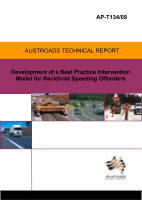Road Safety

- Publication no: AP-T134-09
- ISBN: 978-1-921551-31-4
- Published: 1 May 2009
- PDF (free) Download
Speed-related crashes are a continuing concern in Australasia. On behalf of Austroads, ARRB Group undertook to develop a framework for an intervention to promote safe driving among recidivist speeders.
Five key tasks were carried out: a literature review to investigate the scale and nature of speeding on the Australasian road network; an overview of key models of behaviour change; a literature review and consultations to identify interventions currently available for recidivist speeders; development of a best practice model that explores technological and behaviour change interventions, and how these should be applied to recidivist speeding offenders; the outlining of an appropriate method for the trial and evaluation of the proposed models. The most promising intervention option involves a combination of in-vehicle technology and driver education.
- SUMMARY
- 1. INTRODUCTION
- 1.1. Background
- 1.2. Project Scope
- 1.3. Project Objectives
- 2. METHOD
- 2.1. Literature Review
- 2.2. Consultation with Road Safety Practitioners
- 3. OVERVIEW OF SPEED AS A ROAD SAFETY ISSUE
- 3.1. What is Speeding?
- 3.2. Speed and Risk
- 3.3. The Extent of Speeding in Australia and New Zealand
- 4. RECIDIVIST SPEEDERS
- 4.1. Definitions of Recidivism in the Speeding Context
- 4.2. Characteristics of Recidivist Speeders
- 4.3. Subtypes of Speeder
- 4.4. Implications of the Nature of Recidivists
- 5. EDUCATIONAL APPROACHES
- 5.1. Speed Awareness Scheme and its Predecessors
- 5.2. The Televerket Road Safety Improvement Course
- 5.3. Australian Examples
- 5.4. Summary
- 6. IN-VEHICLE TECHNOLOGY POSSIBILITIES FOR MANAGING SPEEDS
- 6.1. Intelligent Speed Adaptation (ISA)
- 6.2. Summary
- 7. BEHAVIOUR CHANGE MODELS
- 7.1. Health Belief Model
- 7.2. The Theory of Planned Behaviour
- 7.3. Social Cognitive Theory
- 7.4. Other Behaviour Change Models, Overlap, and What is Important in the End
- 7.5. A Communication Model
- 8. TOWARDS A BEST PRACTICE MODEL
- 8.1. Intervention Format
- 8.2. Intervention delivery
- 8.3. Course Aims and Monitoring and Evaluation
- 8.4. Intervention Alignment with Best Practice
- 9. HOW WOULD IT BE PILOTED?
- 9.1. Outcome Evaluation Options for Different Types of Intervention
- 9.2. Size of Trial
- 9.3. Control and Comparison Groups
- 9.4. Need for Random Assignment
- 9.5. Process Evaluation
- 10. CONCLUSIONS
- REFERENCES
- APPENDIX A CONSULTATION INTERVIEW SCHEDULE
